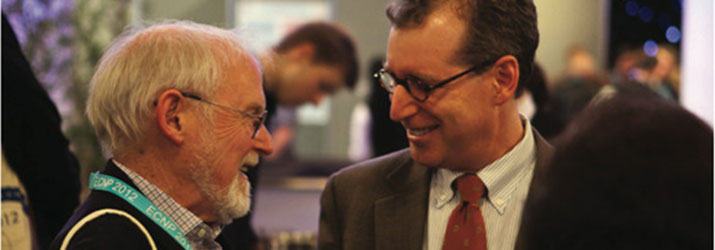
An invitation from the European Confederation of Neuropathological Societies (Euro-CNS) and the British Neuropathological Society drew almost 400 participants from across the globe to the Edinburgh International Conference Centre for this Neuropathology Congress. The meeting was preceded by the Euro-CNS training course on Leukoencephalopathies.
Plenary Lectures
The programme included plenary lectures by eight distinguished speakers working at the forefront of neuroscience research and its application to improvements in diagnosis and treatment. In his talk on the molecular pathology of CNS tumours, Professor David Louis focused on developments in this rapidly expanding field that have been translated into valuable diagnostic and prognostic tools. An example was the use of MGMT promoter methylation to help distinguish glioblastoma recurrence from pseudoprogression during temozolomide therapy. Professor John Hardy discussed how advances in sequencing and DNA chip technology are being used to identify different types of genetic risk for neurodegenerative diseases, thereby increasing understanding of the aetiologies. Professor Richard Gilbertson described his laboratory’s cross-species genomics approach to the subgrouping of CNS tumours. This is helping to explain why tumours of similar histopathological appearance may show very different biological behaviours. For example, ependymomas arising in the forebrain,hindbrain and spinal cord have distinct molecular profiles, reflecting their different stem cell type origins. Professor William Brown illustrated his techniques of creating three dimensional views of vascular networks to investigate the vascular changes in deep white matter in ageing, neurodegeneration and dementia. The increasing complexity and diversity of prion diseases were discussed by Professor Pierluigi Gambetti. He talked about the identification and characterisation of novel forms such as variably protease-sensitive prionopathy which is suggested to represent a sporadic form of Gerstmann-Sträussler-Scheinker disease. Professor Ingmar Blümcke described how the survey of over 5,000 surgical epilepsy specimens collected at the European Epilepsy Brain Bank has enabled correlation between histopathology, preoperative imaging and clinical response to surgery, which in turn is leading to more specifically tailored resection strategies. Developments in understanding the pathogenesis of lysosomal diseases were explained by Professor Steven Walkley. He showed that the complex role of lysosomes within a major metabolic regulatory network indicates that brain dysfunction in lysosomal diseases is not simply the consequence of abnormal storage of non-degraded materials. In the final lecture to the Congress, Professor Robin Franklin described the work in his laboratory on the biology of remyelination. The findings show that declining efficiency of remyelination with age is largely due to failure of stem cell differentiation. Evidence that the innate immune response has a key role in remyelination led to an interesting discussion on the effects of anti-inflammatory therapy in multiple sclerosis.
Seminars and Workshops
A total of 10 symposia and 7 workshops provided platforms to discuss aspects of research and diagnostic practice related to a wide range of neurological/neurosurgical disorders. There were sessions dedicated to regenerative neuroscience and to brain inflammation. A personal highlight was the lecture by Professor Arie Perry in which he presented a very practical approach to the subtyping of glioblastomas, with emphasis on the clinical relevance of making the distinctions.
Posters
Over two hundred posters,grouped into ten themes,were displayed in the exhibition hall throughout the Congress, giving ample opportunity for viewing. The standard was high and twenty-six poster presenters were invited to give oral presentations within the above symposia and workshops. In addition, there were two plenary poster discussions. For these, eight discussants were asked to reflect on what they had found of interest among the posters. I enjoyed the different approaches taken by the eight individuals to present their choices and seeing which strategies had most success in promoting audience participation in the ensuing discussions.
Social Events
The large exhibition hall provided a place to encounter old friends and make new acquaintances. On day two the delegates were treated to an exclusive evening reception in Edinburgh Castle. This included a chance to view Scotland’s Crown Jewels and experience the stirring sounds of a pipe band through the mist over Crown Square. The Gala Dinner was held in the newly refurbished National Museum of Scotland, surrounded by the eclectic Window on the World exhibition in the Grand Gallery. Entertainment was provided by the excellent Kilter Ceilidh Band and I observed that many eminent neuropathologists are also adept at Strip the Willow and other traditional dances performed that night.
Conclusions
The scientific programme was scheduled so that in general sessions with a bias towards clinical diagnostics ran alongside those with a more dedicated research content.This allowed delegates to select the topics most relevant to their areas of interest and there was truly ‘something for everyone’ throughout the Congress. Inevitably clashes occurred and so we hopped between the auditoria to catch the anticipated highlights from each symposium and workshop. Some of the sessions suffered from less than strict timekeeping,thus limiting the opportunities for discussion and one of the plenary poster sessions had to be cut short. In the welcome addresses there had been references to the inclement weather and to the recent outbreak of Legionnaires’ disease in Edinburgh. Nonetheless I am sure that most delegates remained within the Conference Centre each day not because of these external factors but as a consequence of such an informative and enjoyable meeting.
The Abstracts of the 10th European Congress of Neuropathology are published in: Clinical Neuropathology. 2012;31(4):232-5.
Details of future Euro-CNS events, including the neuropathology training courses, can be found at: www.euro-cns.org